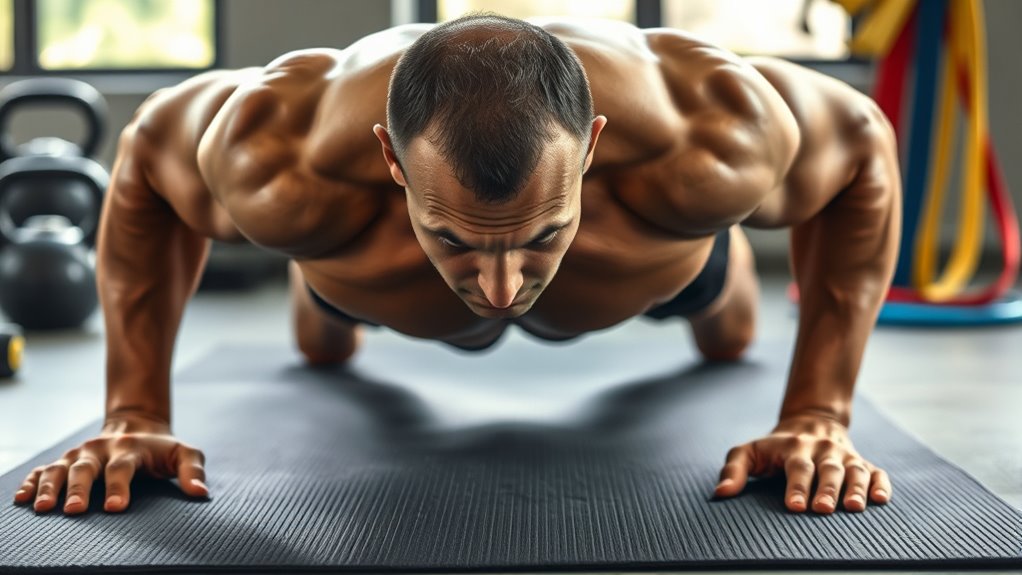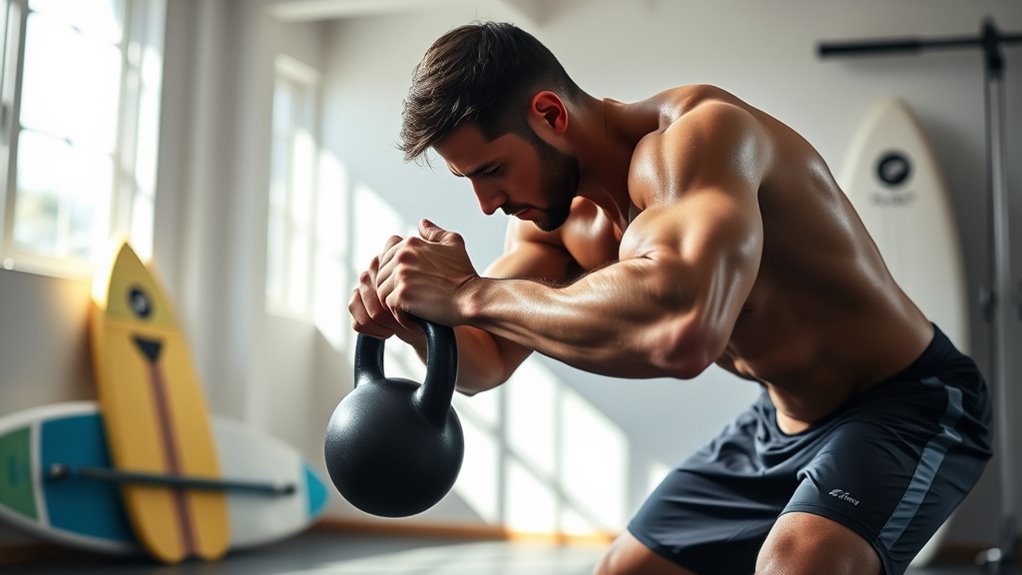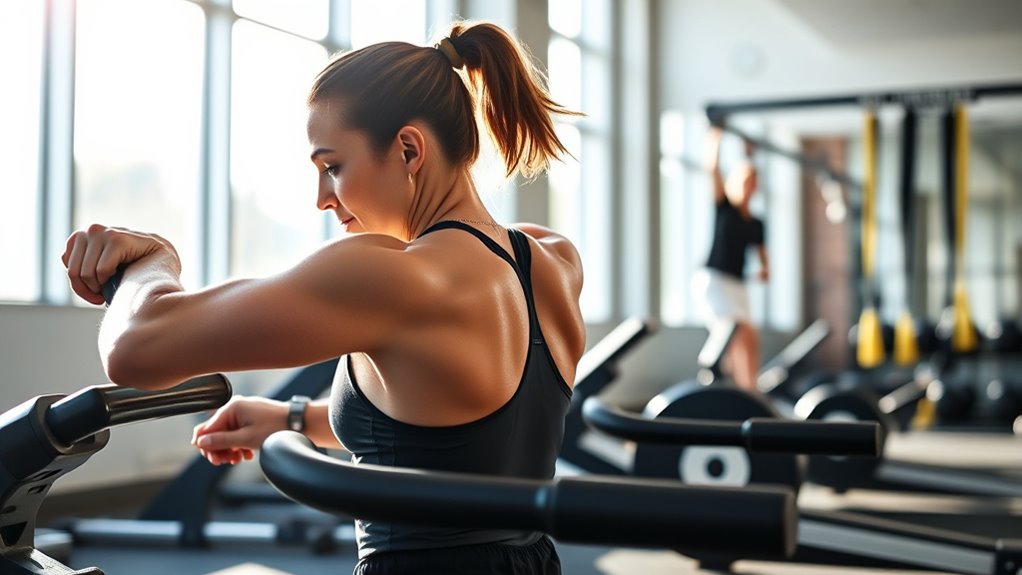To build upper-body strength for paddle sports, focus on exercises that target your shoulders, back, and arms like resistance band rows, push-ups, and shoulder presses. Use proper technique, engage your core, and gradually increase resistance or reps to boost power and endurance. Incorporate functional movements that mimic paddle strokes to improve coordination and prevent injury. Keep progression steady while paying attention to recovery, so you’ll develop strength safely—exploring further will help you optimize your training plan.
Key Takeaways
- Incorporate resistance exercises like band rows, dumbbell presses, and kettlebell swings to target paddling muscles.
- Focus on proper technique and posture to maximize muscle engagement and prevent injuries during training.
- Use progressive overload by gradually increasing resistance, reps, or intensity to build strength effectively.
- Include core stabilization exercises to enhance transfer of power and maintain balance during paddle strokes.
- Prioritize recovery, stretching, and proper nutrition to support muscle growth and prevent overuse injuries.
Understanding the Key Muscles for Paddle Sports

To excel in paddle sports, mastering the key muscles involved in your upper body is essential. Focus on muscle activation in your shoulders, back, and arms, which power your strokes. Strong activation guarantees efficient movement and reduces fatigue. Equally important is maintaining proper postural alignment; it keeps your muscles working at their best and prevents injury. Your core muscles support your posture, allowing for better control and force transfer during paddling. Engaging your lats, rhomboids, deltoids, and biceps helps generate power and stability. When your muscles activate correctly and your posture stays aligned, you’ll notice improved endurance and smoother strokes. Additionally, understanding how vetted products and proper techniques can enhance your training ensures safer progress and better performance. Recognizing the importance of ergonomic equipment can further optimize your paddling efficiency and reduce the risk of strain. Incorporating targeted strength training exercises, such as resistance band workouts, can accelerate muscle development and improve overall paddling performance. Developing awareness of muscle activation techniques can help ensure you’re engaging the right muscles during each stroke, maximizing efficiency. Understanding these muscles’ roles sets a solid foundation for building strength and mastering paddle techniques.
Essential Strengthening Exercises for Upper Body Power

To build upper-body power for paddle sports, you should focus on key exercises like resistance band rows, push-up variations, and dumbbell shoulder presses. These movements target the muscles you use most during paddling, enhancing strength and endurance. Incorporating them into your routine will help you paddle more efficiently and with less fatigue. Additionally, exploring Kia Tuning options such as performance upgrades can inspire you to optimize your training equipment and vehicle accessories for better performance. Understanding Retirement Planning strategies can also help you allocate resources for advanced training gear or coaching services to improve your fitness journey, especially considering residency requirements that might affect access to specialized training programs.
Resistance Band Rows
Resistance band rows are an effective way to build upper-body strength essential for paddle sports. They target key muscles used in your paddle stroke, boosting paddle stroke power and endurance. To maximize benefits, focus on proper form: keep your back straight, engage your core, and squeeze your shoulder blades together. Incorporate resistance band rows into your routine consistently to see improvements in pulling strength and stability.
Key benefits include:
- Enhancing muscle engagement for a more powerful paddle stroke
- Improving back and shoulder stability
- Increasing overall upper-body endurance for longer sessions
Push-Up Variations
Push-up variations are a versatile and effective way to build upper-body power essential for paddle sports. Incorporate different styles to target various muscles and improve overall strength. Handstand push-ups challenge your shoulders, triceps, and core, helping you develop stability and pressing power. Plyometric push-ups add explosive strength, increasing your ability to generate force quickly—crucial for paddling maneuvers. Elevate your hands or feet to modify difficulty, and focus on controlled movements to maximize benefits. These variations not only enhance muscle recruitment but also boost your coordination and balance. Regularly integrating handstand and plyometric push-ups into your training will improve upper-body endurance, power, and responsiveness, translating directly to better control and strength on the water. Additionally, passive voice detection can help you identify and revise sentences for clearer, more direct communication. Incorporating training variety can further enhance muscle engagement and prevent workout plateauing. To optimize your workout, consider incorporating progressive overload principles to gradually increase intensity and continue making gains. Engaging in diverse exercises and techniques can also help reduce muscle fatigue and promote balanced development.
Dumbbell Shoulder Press
Building upper-body strength for paddle sports involves targeting key muscles used in paddling motions, and the dumbbell shoulder press is a highly effective exercise for this purpose. This move enhances muscle activation in your shoulders, deltoids, and upper back, which are vital for powerful strokes. When performing a dumbbell shoulder press, focus on controlled movement and proper form to maximize strength gains. It not only builds strength but also improves shoulder stability and endurance, essential for long paddling sessions. Incorporating this exercise into your routine can contribute to overall muscle development and athletic performance. Additionally, understanding the support hours of local facilities can help you plan your training sessions more effectively, ensuring you have ample time to practice and improve. Recognizing the methodologies and objectives of different training approaches can further optimize your strength training for paddle sports. Moreover, selecting the right projector technology can significantly enhance your viewing experience during recovery or rest periods, helping you stay motivated.
Incorporating Functional Movements Into Your Routine

Incorporating functional movements into your routine can substantially enhance your upper-body strength for paddle sports. These movements mimic real-life activities, helping you develop core stability and improve coordination. Exercises like kettlebell swings, medicine ball throws, and push-up variations engage multiple muscle groups simultaneously, building strength and stability essential for paddling. They also boost cardiovascular endurance, enabling you to sustain effort during long sessions. By focusing on movement patterns that replicate paddle strokes, you ensure your muscles work together efficiently. This integrated approach not only increases strength but also enhances balance and agility. Additionally, understanding the importance of Gold IRA rules and regulations can guide you in selecting exercises that maximize your training effectiveness. Developing active listening and empathy during your workouts can also improve your ability to tune into your body’s needs and responses, leading to more effective training sessions. Incorporating these functional exercises regularly helps you build a resilient, well-rounded upper body, making your paddle sports experience more powerful and enjoyable.
Designing a Balanced Training Schedule

Creating a balanced training schedule is essential for maximizing your upper-body strength and endurance for paddle sports. To do this effectively, incorporate a mix of strength, cardio, and recovery sessions. Prioritize nutrition planning to fuel your muscles and boost recovery, ensuring consistent progress. Proper hydration is vital to maintain performance and prevent fatigue during intensive workouts. Mental focus is equally important; stay committed and mindful during workouts to improve form and prevent burnout. Incorporating relaxation techniques can also help reduce tension and improve overall performance. Additionally, including targeted exercises that enhance muscular endurance can further improve your paddling efficiency and stamina. Varying your training intensity and incorporating progressive overload ensures continued strength development over time.
Tips for Preventing Injuries During Training

To stay injury-free during training, start with proper warm-up techniques to prepare your muscles. Progress gradually by increasing load and intensity to avoid overstraining. Make sure to incorporate rest and recovery strategies to give your body time to heal and strengthen. Additionally, understanding proper technique can significantly reduce the risk of injury and improve your overall performance. For optimal results, consider coaching experience to refine your form and prevent common mistakes.
Proper Warm-up Techniques
Before diving into intense training, taking time to properly warm up can considerably reduce your risk of injury. A good warm-up prepares your muscles and sharpens your focus through effective stretching routines and mental preparation. Start with light cardio to increase blood flow, then incorporate dynamic stretches targeting your shoulders, back, and arms. This not only loosens up your muscles but also enhances flexibility. Remember to breathe deeply and stay mindful of your body’s signals. To maximize your warm-up, consider these key tips:
- Perform dynamic stretches that mimic paddle movements
- Focus on mental preparation to improve concentration
- Gradually increase intensity to avoid overstressing muscles
These steps help you stay safe and ready for a productive workout.
Gradual Load Progression
Progressively increasing your training load is essential to prevent injuries and build strength safely. Jumping into intense workouts too quickly can heighten overtraining risks, leading to fatigue or even injuries. To avoid this, gradually add reps, sets, or resistance over several sessions. Listening to your body is crucial—if you experience persistent soreness or fatigue, scale back and allow proper adaptation. Nutrition strategies also play a vital role; fueling your muscles with adequate protein, carbs, and hydration supports recovery and reduces injury risk. Remember, patience is key. By slowly ramping up your workload and maintaining good nutrition, you minimize overtraining risks and ensure steady progress without setbacks. This approach promotes sustainable strength gains and keeps you injury-free.
Rest and Recovery Strategies
Incorporating effective rest and recovery strategies is vital to prevent injuries and guarantee continuous progress in your paddle sports training. Adequate rest allows your muscles to repair and adapt, reducing the risk of overuse injuries. Focus on incorporating stretching routines post-workout to improve flexibility and reduce soreness. Sleep optimization is critical—aim for quality sleep to support muscle recovery and mental alertness.
To stay safe and avoid setbacks, consider these strategies:
- Prioritize rest days and listen to your body’s signals
- Incorporate targeted stretching routines after training sessions
- Ensure consistent sleep patterns for maximum recovery
Implementing these practices helps you stay injury-free and keeps your upper-body strength training on track.
Tracking Progress and Adjusting Your Program

Tracking your progress is essential to guarantee you’re on the right track and making gains in upper-body strength for paddle sports. By monitoring tracking metrics like reps, weight, and pain levels, you can see what’s working and where improvements are needed. Regularly review these metrics to identify plateaus or setbacks early. Adjust your workout intensity accordingly—if you’re progressing steadily, consider increasing resistance or volume. Conversely, if you’re feeling fatigued or not improving, scale back to allow recovery. Consistent tracking helps you stay motivated and ensures your program remains effective. Remember, small, steady adjustments based on your data lead to better results and reduced risk of injury, keeping your training aligned with your goals for paddle sports excellence.
Frequently Asked Questions
How Long Does It Typically Take to See Improvements in Upper-Body Strength for Paddle Sports?
You’ll start noticing improvements in your upper-body strength within 4 to 6 weeks, depending on your training frequency and how well you target specific muscle groups. Consistent workouts 3-4 times a week, focusing on key muscles like shoulders, back, and arms, accelerate progress. Keep challenging yourself with increased resistance or repetitions, and you’ll see gains faster, helping you become more confident and efficient in paddle sports.
Are There Specific Training Considerations for Different Types of Paddle Sports (E.G., Kayaking vs. Stand-Up Paddleboarding)?
Different paddle sports like kayaking and stand-up paddleboarding require specific training considerations due to equipment differences and muscle engagement. For kayaking, focus on core stability and back muscles, while stand-up paddleboarding emphasizes balance and shoulder strength. Adjust your workouts to target the muscles most used in each sport, incorporate sport-specific movements, and guarantee your training mimics real paddling motions for better performance and injury prevention.
Can Beginners Safely Start an Upper-Body Strength Program Without Prior Experience?
Did you know that 70% of beginners see injuries when rushing into strength routines? You can start an upper-body program safely by focusing on a proper warm-up to prepare your muscles and joints. Always prioritize equipment safety, like using appropriate weights and correct form. If you’re new, begin with light exercises, listen to your body, and gradually increase intensity to avoid strain and build strength confidently.
How Should I Modify My Training if I Have Existing Shoulder or Back Injuries?
If you have shoulder injuries or back issues, you should modify your training carefully. Focus on shoulder stabilization exercises that strengthen without overloading your joints, and prioritize back injury management with gentle stretches and low-impact movements. Avoid heavy weights or high-impact activities until your doctor or physical therapist clears you. Listen to your body, progress gradually, and always seek professional guidance to prevent further injury.
What Are the Best Recovery Strategies to Enhance Strength Gains and Prevent Fatigue?
To enhance strength gains and prevent fatigue, focus on smart recovery strategies. Prioritize proper nutrition timing, eating protein and carbs after workouts to fuel recovery. Stay hydrated and get enough sleep to support muscle repair. Cultivate mental resilience by managing stress and practicing mindfulness, which helps your body recover faster. Incorporate active rest days and listen to your body to avoid overtraining, ensuring you build strength effectively and safely.
Conclusion
Building upper-body strength for paddle sports is like planting seeds in fertile soil—you’ll see your skills blossom with consistent effort. Keep nurturing your muscles with purpose and care, and you’ll navigate the waters with confidence and grace. Remember, your progress is a river flowing steadily—stay committed, adapt as needed, and enjoy the journey. With patience and persistence, you’ll turn your strength into a powerful current that propels you forward on every paddle stroke.










